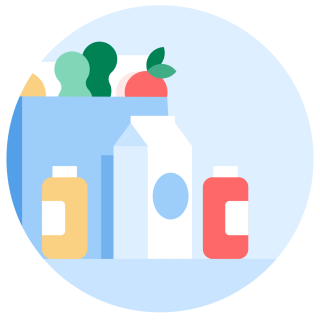How to Save Money on Groceries: 14 Tips to Try
Visit the grocery store less often and make your shopping more strategic when you go.

Many, or all, of the products featured on this page are from our advertising partners who compensate us when you take certain actions on our website or click to take an action on their website. However, this does not influence our evaluations. Our opinions are our own. Here is a list of our partners and here's how we make money.
Eating at home is the tried and true way to save money on meals, but food-at-home prices are expected to increase 1.3 percent in 2025, according to the U.S. Department of Agriculture. While sharp rises in the cost of kitchen staples like eggs and meat have made food at home more expensive, you're likely still better off buying groceries over takeout.
The right supermarket shopping strategies can help you keep costs down. If you’re feeling sticker shock at the store, here's how to save money on groceries.
1. Check what you already have and make a list
Some shoppers head to the grocery store without taking inventory of what they already have at home. Before you buy one too many loaves of bread or gallons of milk, check your refrigerator and pantry. Snap a picture of what you already have, make a list of what you know you’ll need or use an app to help you track pantry items. For example, KitchenPal can monitor your pantry inventory and suggest recipes based on the food you have.
2. Limit your shopping trips
It helps to limit your trips to the store, too, according to Steve and Annette Economides of MoneySmartFamily.com. The less you’re physically at the store, the couple says, the fewer opportunities you have for impulse purchases.
3. Stick to your list
About those impulse buys: Using a grocery list and sticking to it can help fight the urge to spend more than you'd planned. Consider shopping alone so you can get in and out quickly, without kids lobbying for items not on the list or in your budget.
» MORE: Best grocery list apps
4. Pay attention to prices
Passive shopping won’t cut it in this age of inflation. You should actively assess the prices of the items you buy on a regular basis so you know when to pounce on a deal or pass. This technique is as simple as being mindful about what you’re doing while you shop. Pay attention to prices at more than one local store to learn where deals on certain products are better. And watch out for shrinkflation, too, as well as total price — if the package size goes down but the price the same, you're paying a higher unit cost.
5. Check your mail and email
Look in the Sunday paper for coupons

Don’t want to spend on the Sunday Post or Times? Check your mail for grocery store coupons. Many grocery stores also have apps and email lists with coupons, discounts and rewards programs to save even more.
6. Know your shopping style
Do you prefer shopping for groceries online or in stores? Each comes with pros and cons. Online grocery services and subscriptions are convenient, but they can also be costly.
For others, online shopping could lead to savings. It reduces the temptation to add items to your cart that aren’t on your list, especially the impulse goods lining checkouts. Knowing your shopping style can help you choose a method that works best for you.
» MORE: Is Amazon Prime worth it?
7. Calculate your burn rate
Your burn rate refers to how frequently you use up products, say Steve and Annette Economides. They recommend figuring out how long certain products last you, then stocking up on deals accordingly.
If you have room in your freezer to buy a few extra sale-priced chickens, go for it. But if your favorite bagged chopped salad is on sale and you buy more than you can eat before the expiration date, you’ll end up overspending.

8. Follow your favorite brands
You probably already have a favorite potato chip or a top pick in laundry detergent, so use your brand loyalty to your advantage.
Follow your favorite brands on social media or sign up for their mailing lists. Tide laundry detergent deals and Seltzer brand Spindrift offers are sent directly to the inboxes of email subscribers.
9. Try out generic labels
But just because you like Tide or Spindrift doesn’t mean you shouldn’t be open to trying something else. For some products, you can do without the brand name altogether.
For instance, if you’re indifferent about the hair product you use, you may try out a budget brand like Suave or a store like Target’s generic version of Head & Shoulders.
10. Use credit cards strategically
Check your credit cards to see if you can earn cash back or other rewards when grocery shopping. You'll need to track details like spending caps, possible annual fees and rotating categories. But rewards credit cards can pay 1% to 6%, which could shave hundreds of dollars a year off your food costs. To reap the best return, pay the card off in full each month rather than carrying a balance. Otherwise, interest charges may eat up your savings.
11. Establish your local supermarket circuit
Split your purchases across multiple stores to pinpoint the best deals at each, and hone your system. For example, you may use Trader Joe’s for good deals on items like ground coffee and frozen prepared meals one week. Then the next week, you’ll go to the local Aldi for discounts on center-store items like boxed cereals and snacks. Grab your meat and produce where you can find it freshest for the best price, and hit the wholesale club once a month for the things you can stock, save and use over time.
12. Consider a wholesale membership

And remember, you’ll have to pay an annual fee for the warehouse membership. Before you commit, ensure that you’ll shop there enough to save more on your groceries than you invest in the membership. If you do, check out their gas price perks, too.
13. Look at the price per unit
Take note of how much you’re getting for your money. The price per unit (ounce, pound, gram, etc.) of different packages is often printed on the pricing display near the product. You also can use a unit price calculator to determine the cost per unit. The information is helpful since some stores sell identical products in different sizes. You can also look for local farmers that sell shares of beef or poultry to lower the price per unit.
Be aware of “shrinkflation” — when that jar of peanut butter gets deceptively smaller but stays the same price. If you notice it, pivot to a brand that hasn’t downsized.
14. Understand sale cycles
Holidays like Christmas, Easter, Valentine’s Day and Halloween are known for their candy sales. If you want to snag a bargain, shop the clearance section after the holidays are over. Stores will deeply discount their seasonal merchandise, and you can stock up for a low price.






